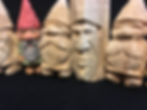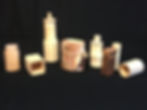
I have been slowly working on a series of voyageurs. These were the men who paddled the birch bark freight canoes in the Northwest fur trade and were known to carry heavy loads (180 lbs.) of trade goods on their backs across portages where the canoes could not be paddled. I am fascinated by their strength, their diverse cultural backgrounds and the colorful fashions they were known to wear.


I have been slowly working on a series of voyageurs. These were the men who paddled the birch bark freight canoes in the Northwest fur trade and were known to carry heavy loads (180 lbs.) of trade goods on their backs across portages where the canoes could not be paddled. I am fascinated by their strength, their diverse cultural backgrounds and the colorful fashions they were known to wear.

This figure is showing a typical French-Canadian voyageur, the men who paddled the large birch bark freight canoes in the Northwest fur trade in the 18th and 19th centuries. Jean Baptiste was a very common name among the voyageurs. He sits on a bale of trade goods and holds his paddle in his hand, taking a break on an arduous portage. He still needs a little pipe in his mouth, as these fellows were know to take frequent smoke breaks.


I started carving little songbirds with children while teaching woodwork at a Waldorf school. I found this to be a great project to get people using their hands, learning to carve and paying more attention to the small songbirds all around them. When one carves and paints a specific bird, it helps to create more of a connection to that bird.



Krympburkar is a Swedish name meaning "shrink jar". These containers are made by hollowing a green section of birch branch. Then a base plug of dry wood is inserted in a groove in the bottom. When the cylinder dries, it tightens around the plug, forming a nice little jar to store things in. They are not a drinking vessel but rather a container for tea, spices, pencils or other dry goods.
My wood carving is inspired by the Scandinavian carving traditions. The figures I carve are done in the flat-plane carving style which has been popularized by a variety of Swedish and Norwegian carvers over the past century and by Scandinavian immigrants to the U.S. In this carving style, the knife cuts are intentionally left visible, creating angular facets that the light and shadow play upon. In general much of the carving is done with just one small knife. The subject matter I enjoy are historical and mythical figures, as well as birds. The other form of carving I practice is called "green wood carving." This is a type of wood carving well suited to making utilitarian objects such as, bowls, spoons, ladles, cutting boards and small containers. Please check my Etsy Shop for what items I have in stock or feel free to contact me for custom orders.